A. To assess the student’s ability to recognize words and determine the reading level, it is necessary to use graded word lists and graded text passages to conduct the informal reading inventory (IRI). IRI is important to choose the reading material of the appropriate level for students (Gunning, 2010, p. 64). The independent, instruction, and frustration reading levels of two students (Student A, Student B) were determined separately.
Student A
Word List of Common Sight Words
Word List Level Two
Word List Level Three
Note. Student A experienced difficulties while recognizing words from Word List Level Three and demonstrated the last perfect performance at Level Two. Thus, the IRI should be started from Level One.
Student B
Word List of Common Sight Words
Word List Level Two
Word List Level Three
Word List Level Four
Note. Student B experienced difficulties while recognizing words from Word List Level Four and demonstrated the last perfect performance at Level Three. Thus, the IRI should be started from Level Two.
Informal Reading Inventory (IRI)
Student A: Informal Reading Inventory Summary
Student A: Informal Reading Inventory
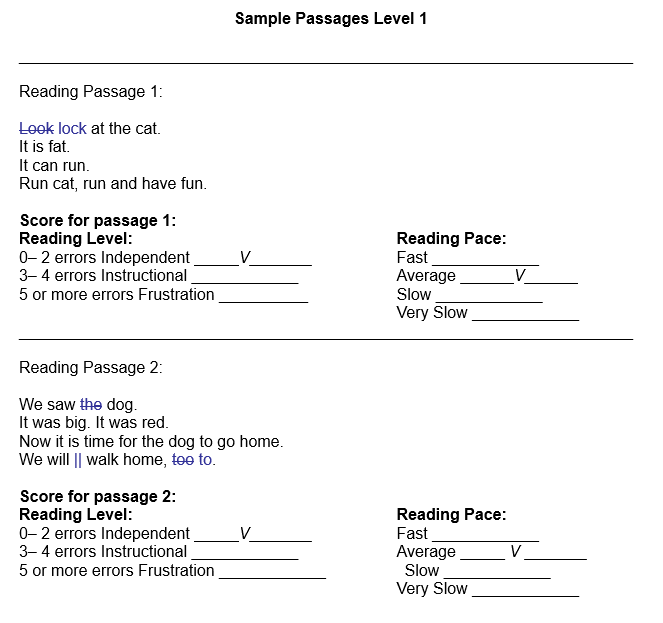
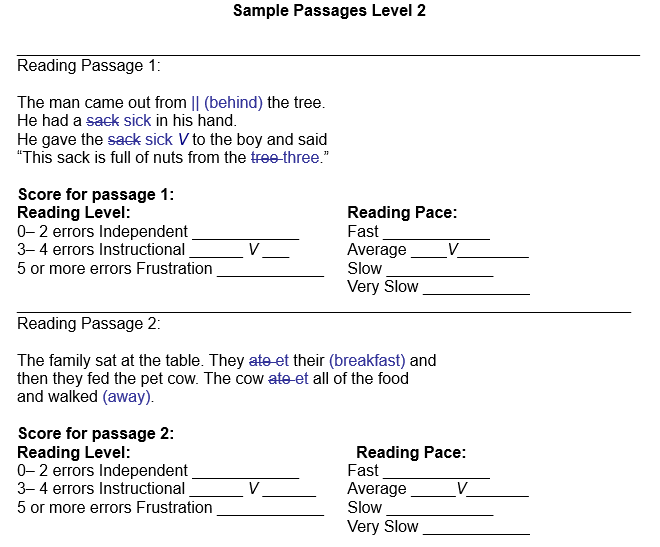
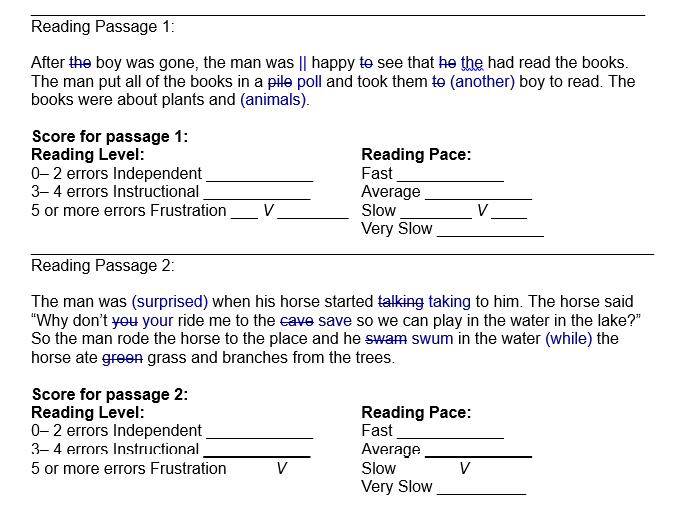
Student B: Informal Reading Inventory Summary
Student B: Informal Reading Inventory
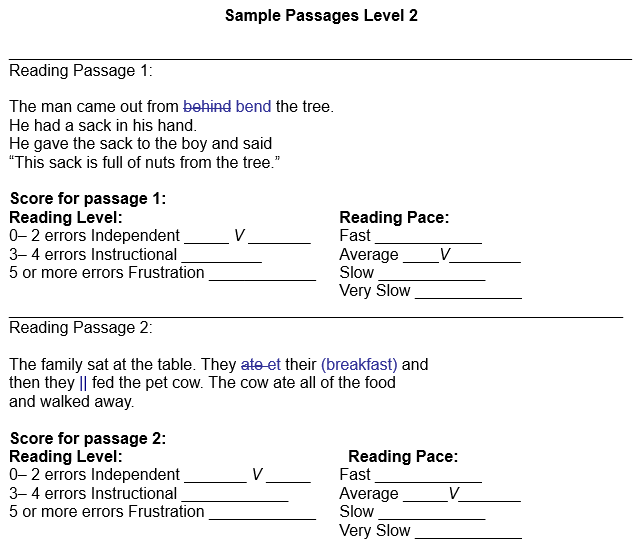
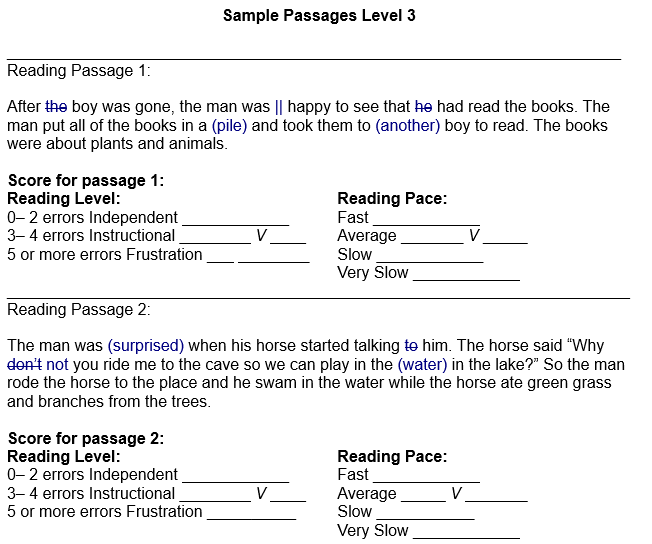
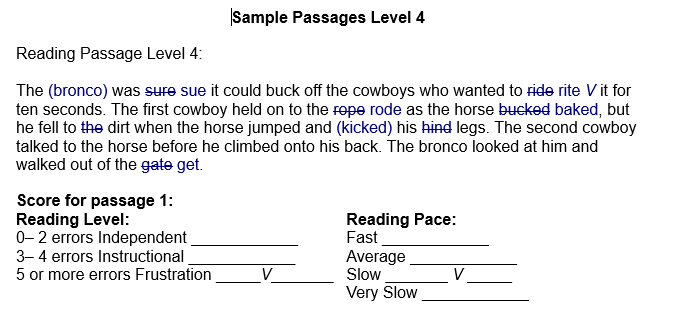
Student A: Miscue Analysis Summary Form
To analyze the reading skills of Student A, it is necessary to focus on the miscues made by the student while reading the IRI passages. However, it is important to pay attention to the miscues which are typical for the student’s independent and instructional reading levels. The reading pace of Student A is average. Hesitations and pauses are rare. Nevertheless, the student is inclined to mispronounce words, making substitutes which have no sense in the context of the sentence. It is important to note that the student does not use non-words, but Student A fails to use the context clues to recognize and pronounce words correctly. It is necessary to improve the phonics skills. The other skill which requires improvement is the student’s vocabulary. The student experiences difficulties with recognizing words which have more than one syllable (behind, breakfast).
To improve the phonics skills and the student’s pronunciation, it is necessary to provide the student’s with the list of the letter combinations which can sound the same and practice them while recognizing words with the help of flashcards. It is useful to provide the pairs of words which can sound the same or look the same to recognize them, pronounce correctly, and determine the differences in meaning. To overcome difficulties with remembering new words, it is important to use picture-words cards and “fill in the blank” exercises with pictures as clues first, and then without clues, using only the context of the sentence.
Student B: Miscue Analysis Summary Form
Basing on the miscues made on the independent and instructional reading levels, it is possible to note that Student B experiences difficulties while pronouncing short words. Moreover, it is typical for the student to omit definite short words (to, the). Thus, it is important to improve the phonics skills. There are also problems with recognizing two-syllable words. Student B is inclined to ask when the word is unfamiliar rather than to guess how to read it. It is necessary to improve the vocabulary and skills in remembering words with focusing on the context because Student B uses context clues inappropriately. The independent reading level is associated with the student’s grade, but it is possible to improve the student’s skills, concentrating on omissions, mispronunciation, and vocabulary.
To improve the student’s pronunciation, it is necessary to use flash cards for frequently mispronounced words, to use guessing games with pairs of words which are typically mispronounced by the student. The strategy to avoid omissions is based on choral reading, making lists of the common letter combinations and word combinations to practice the student’s focus on the regularly omitted words. Student B should develop skills in remembering and recognizing words without asking for them frequently. It is possible to concentrate on this ability with references to “fill in the blank” exercises, constructing sentences with omitting words, using picture-word flash cards to remember unfamiliar words, underlining and practicing unfamiliar words in sentences.
Student A: Fry Readability Assessment
- The book which is appropriate for Student A for reading at the independent and instructional levels is Fox and His Friends by Edward Marshall (Marshall, 2004). To draw the necessary conclusions about the book’s appropriateness, I have conducted the Fry Readability Assessment.
- I have selected three 100-word passages from the book. I have chosen the extracts from the beginning, middle, and end of the book. Then I counted the number of syllables and sentences in each passage. The actual numbers are presented in the table.
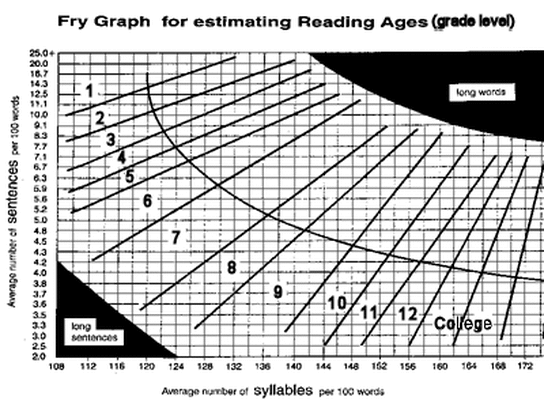
Having made the necessary calculations, I can state the average number of syllables presented in the text is 127.3, and the average number of sentences is 13.2.
According to the Fry Readability Assessment, the average readability of the chosen book is correlated with the second grade. That is why, the book is appropriate for Student A to respond to the independent and instructional levels. Following the results of the assessment, it is possible to use the book for the student without reaching the frustration reading level.
Fox and His Friends by Edward Marshall is appropriate for Student A to meet the instructional level because it is correlated with the second grade. From this point, reading the book, the student cannot reach the frustration reading level. The book can be rather easy to read for Student A, but some unfamiliar or difficult words which can be met in the book responding to the instructional level can help the student to develop and improve reading skills (mispronunciation, substitution, vocabulary) while remembering and recognizing new words.
It is necessary to choose books while using a reading interest survey in order to improve the student’s reading skills basing on encouragement. Moreover, the books should be in the sphere of the student’s interests to attract the child to reading attentively. Student A likes to read books about Fox (Fox at School, Fox on Stage) by Edward Marshall, and Fox and His Friends belongs to the series. That is why, appropriateness of the book was determined with the help of the Fry Readability Assessment. Thus, the book meets the student’s instructional level, and it is chosen according to the student’s interests.
Student B: Fry Readability Assessment
According to IRI, the instructional reading level of Student B is correlated with the third grade. The book which is discussed as appropriate to respond to this level is Could You? Would You? by Trudy White (White, 2007). To confirm appropriateness of the choice, the Fry Readability Assessment was conducted.
I have selected three 100-word passages from the book. I have chosen the extracts from the beginning, middle, and end of the book. Then I counted the number of syllables and sentences in each passage. The actual numbers are presented in the table.
Having made the necessary calculations, I can state that the average number of syllables presented in the text is 137.7, and the average number of sentences is 13.6. According to the Fry Readability Assessment, the average readability of the book is at the third grade, but it is too close to the fourth grade.
That is why, definite sentences and words can be associated with the frustration level of Student B. To avoid the difficulties, it is necessary to monitor the student’s work with the book to help recognize words and guess unfamiliar words.
Following the results of the assessment, it is possible to use Could You? Would You? by Trudy White to meet the instructional level of Student B. The amount of words which are unfamiliar for the student is correlated with the instructional level. Moreover, the teacher’s control while reading the book can help prevent the possible difficulties and avoid frustration. The book is effective to develop the student’s skills in word recognition.
Student B experiences difficulties with remembering words and omitting some words. A reading interest survey can be used to determine the books which are interesting for Student B, and the focus on reading interesting books at the instructional level can help the student remember new or troublesome words. Could You? Would You? by Trudy White belongs to the instructional level and can be discussed as associated with the student’s interests in reading encyclopedias for children and different books with riddles and puzzles.
References
Gunning, T. (2010). Creating literacy instruction for all students. Boston, MA: Allyn and Bacon/Pearson Education.
Marshall, E. (1994). Fox and his friends. USA: Puffin Books.
Readability information and resources. (2012). Web.
White, T. (2007). Could You? Would You? USA: Kane/Miller.